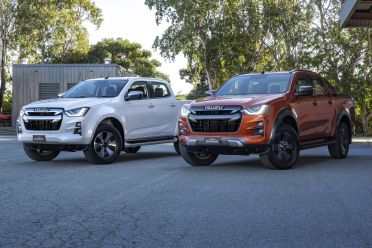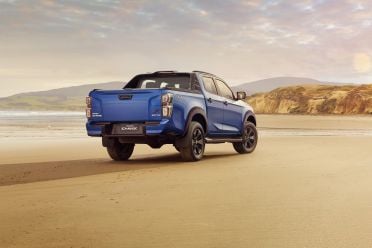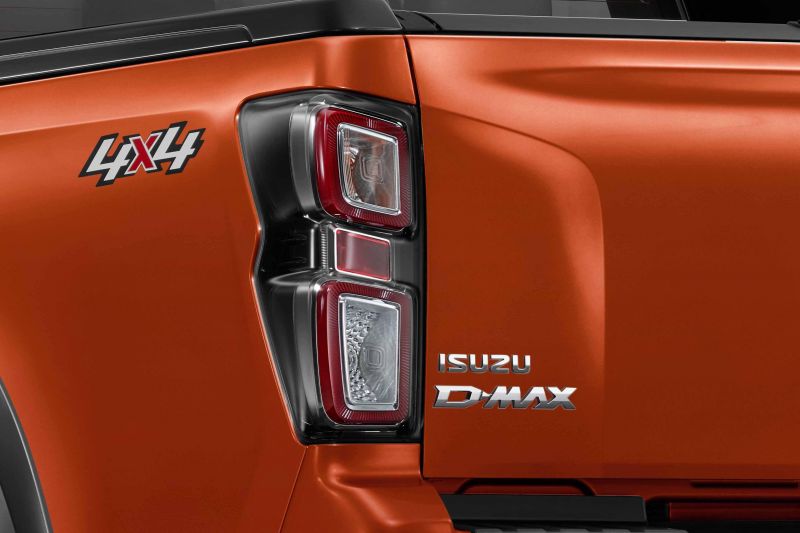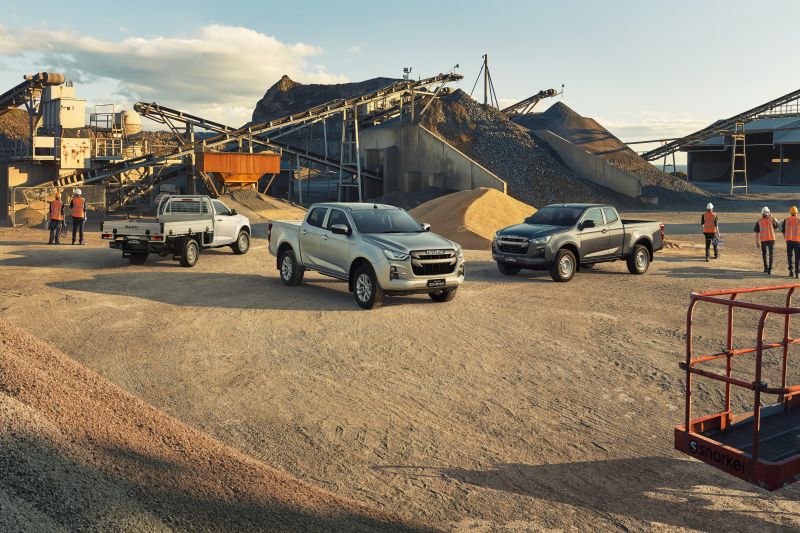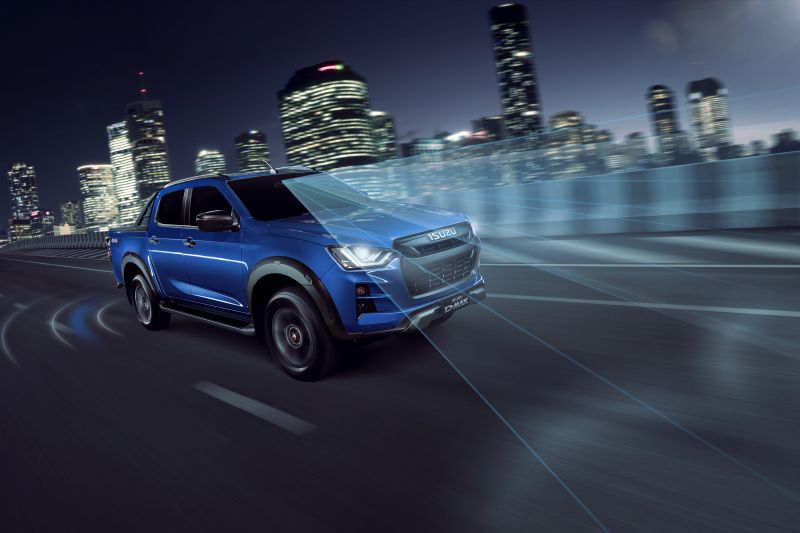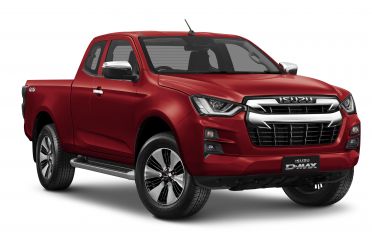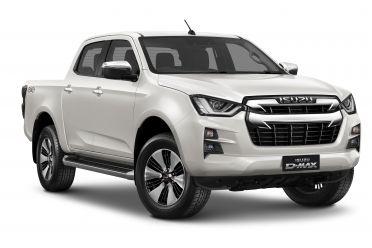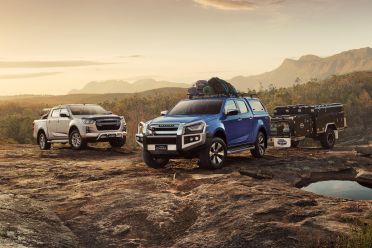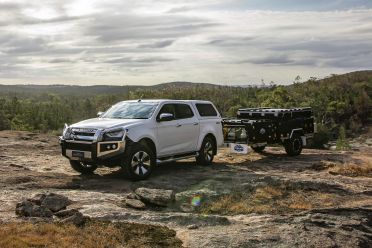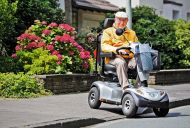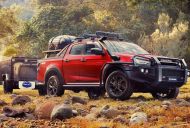It’s finally here. The 2021 Isuzu D-Max has been unveiled in full for Australia.
The twin to the recently-revealed Mazda BT-50 will hit showrooms on September 1, with a steeper starting price to match its new look, new safety technology, and new interior.
Where the old D-Max lacked safety equipment such as autonomous emergency braking, the new car will offer a full suite of driver aids across the range, from the most basic ‘traffic controller’ model to the range-topping X-Terrain.
Its DNA hasn’t changed too much, though. An under-stressed 3.0-litre turbo-diesel engine sits under the bonnet, although it’s been thoroughly overhauled for 2021, and Isuzu has focused on making it a capable tow vehicle.
The range has been pared back for 2021, with just 20 variants on offer. Pricing starts at $32,200 before on-road costs for the single-cab SX 4×2 manual, and extending to $62,900 before on-roads for the new X-Terrain flagship.
It’s worth keeping in mind, Isuzu is offering drive-away prices from launch, and is known for doing sharp deals. The current drive-away deals will be joined by more when the car arrives in dealerships on September 1.
Pricing
4×2
- Single Cab Chassis SX manual: $32,200 ($29,990 drive-away)
- Single Cab Chassis SX: $34,200
- Crew Cab Chassis SX: $40,700
- Space Cab Ute SX: $38,900
- Crew Cab Ute SX: $41,900
- Crew Cab Ute LS-U: $48,900
4×4
- Single Cab Chassis SX manual: $40,200
- Single Cab Chassis SX: $42,200
- Space Cab Chassis SX manual: $43,700
- Space Cab Chassis SX: $45,700
- Crew Cab Chassis SX manual: $46,700
- Crew Cab Chassis SX: $48,700
- Crew Cab Ute SX manual: $47,900
- Crew Cab Ute SX: $49,900
- Crew Cab Ute LS-M manual: $51,000
- Crew Cab Ute LS-M: $53,000
- Space Cab Ute LS-U: $53,900
- Crew Cab Ute LS-U manual: $54,900
- Crew Cab Ute LS-U: $56,900
- Crew Cab Ute X-Terrain: $62,900 ($58,990 drive-away)
All prices exclude on-road costs unless otherwise specified
Engine
Under the bonnet of every D-Max in Australia is a 3.0-litre four-cylinder turbo-diesel engine. Although it shares its displacement and layout with the engine it replaces, Isuzu says the 4JJ3-TCX (catchy!) engine in the all-new D-Max is quieter, more powerful, and more thermally efficient than before.
A six-speed manual is offered on some trim grades, while a six-speed torque converter automatic is available across the range.
Isuzu says the new transmission has different internals to the unit it replaces, and tweaked shift logic for less hunting, and more intelligent behaviour when driving downhill.
Peak power is 140kW and peak torque is 450Nm, the latter available between 1600 and 2600rpm.
Fuel Economy
Although it’s been updated significantly for 2020, the engine in the new D-Max is actually less efficient than the unit it replaces, with claimed economy of between 7.7L and 8.0L/100km depending on the equipment fitted.
Four-wheel drive models feature the same switchable 2H, 4H, and 4L options as before, but Isuzu has addressed one of the biggest criticisms of the current model by adding a locking rear differential as standard.
Dimensions
The dual-cab D-Max with an integrated tray measures 5280mm long and 1870mm wide, or 1880mm wide in the range-topping X-Terrain.
The entire range has a 3125mm wheelbase, and the tallest D-Max X-Terrain measures 1810mm high.
Approach angle is 30.5 degrees, departure angle is 24.2 degrees, and ramp-over angle is 23.8 degrees, while Isuzu claims an 800mm wading depth.
The three-link suspension is new for 2021, and unique to the D-Max in the crowded Australian ute market.
The D-Max will tow a 3500kg braked trailer and has a 350kg maximum down ball load, and payload varies from 970kg in the X-Terrain to 1320kg in the Single Cab Chassis SX.
Safety
The new D-Max hasn’t been crash tested by ANCAP, but Isuzu is confident it will be a five-star car when bumper meets barrier.
Every model will feature a full suite of active safety features, being marketed under the IDAS banner.
Autonomous emergency braking, forward collision warning, turn assist, traffic sign recognition, lane-departure warning, blind-spot monitoring, rear cross-traffic alert, and automatic high-beam are included from the base ‘traffic controller’ model through to the X-Terrain.
Automatic models also feature wrong-pedal acceleration warning, adaptive cruise, and lane-keeping assist.
Eight airbags are standard, including a new central airbag designed to stop the passenger and driver’s flailing arms and heads crashing into each other in a serious side-impact crash.
Standard Equipment
Standard equipment on the D-Max SX includes:
- Autonomous emergency braking
- Forward collision warning
- Lane-departure warning
- Lane-keeping assist (automatic)
- Turn assist
- Wrong-pedal acceleration prevention
- Traffic sign monitoring
- Blind-spot monitoring
- Driver attention monitoring
- Auto high beam
- Reversing camera
- 4.2-inch trip computer display
- 7.0-inch touchscreen infotainment system with wireless Apple CarPlay, wired Android Auto
- Base cloth trim
- Manual air-conditioning
- 17-inch steel wheels
Moving to the LS-M brings:
- ‘High-grade’ cloth trim
- Rear USB connector
- Seat back pockets
- Fold-down central armrest
- Six-speaker audio system
- Bi-LED headlights
- LED daytime running lights
- Body-coloured mirrors
- 17-inch alloy wheels
Jumping to the LS-U adds:
- Rear parking sensors
- Powered lumbar support for driver’s seat
- Leather-trimmed gear knob
- Soft-touch door trim
- Soft central armrest lid
- Vanity mirrors for driver, passenger
- Carpet flooring
- 9.0-inch infotainment touchscreen with wireless Apple CarPlay, wired Android Auto, factory satellite navigation
- Side steps
- LED rear lights
- 18-inch alloy wheels
Finally, the range-topping X-Terrain packs:
- Front parking sensors
- Leather-accented seats
- Powered driver’s seat
- Keyless entry and start
- Remote engine start
- Eight-speaker sound system
- Unique exterior trim
- 18-inch alloy wheels
Servicing
Maintenance for the D-Max is required every 12 months or 15,000km, whichever comes first.
The first seven years of servicing will cost you a combined $3373, laid out below:
- 15,000km: $389
- 30,000km: $409
- 45,000km: $609
- 60,000km: $509
- 75,000km: $299
- 90,000km: $749
- 105,000km: $409
The D-Max is backed by a six-year, 150,000km warranty, and comes with seven years of roadside assist.

